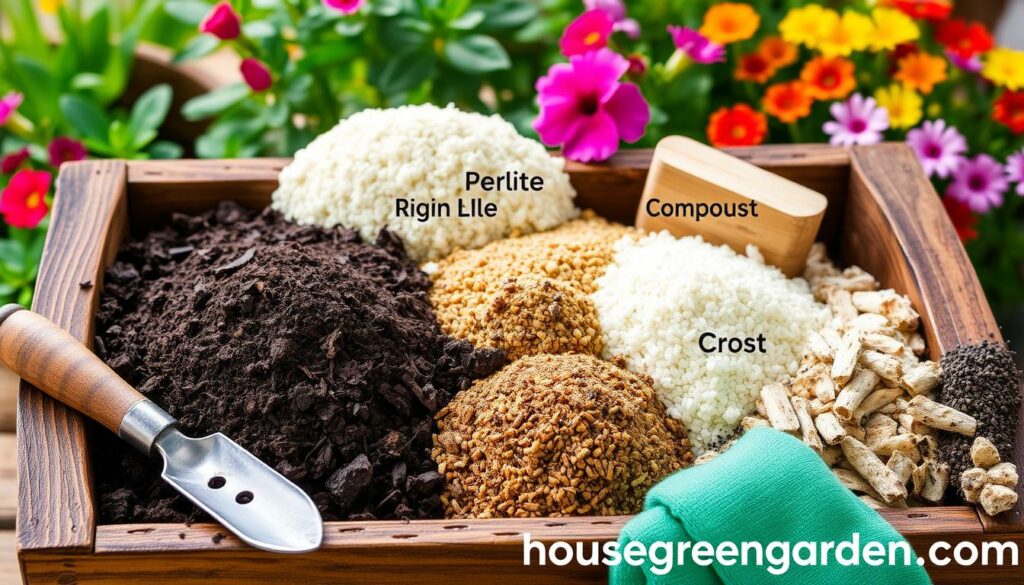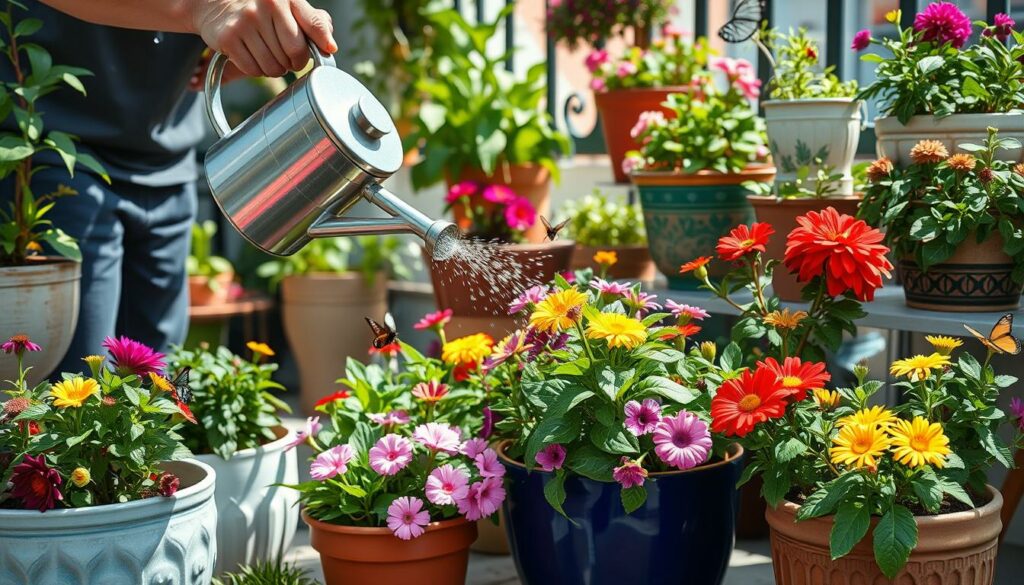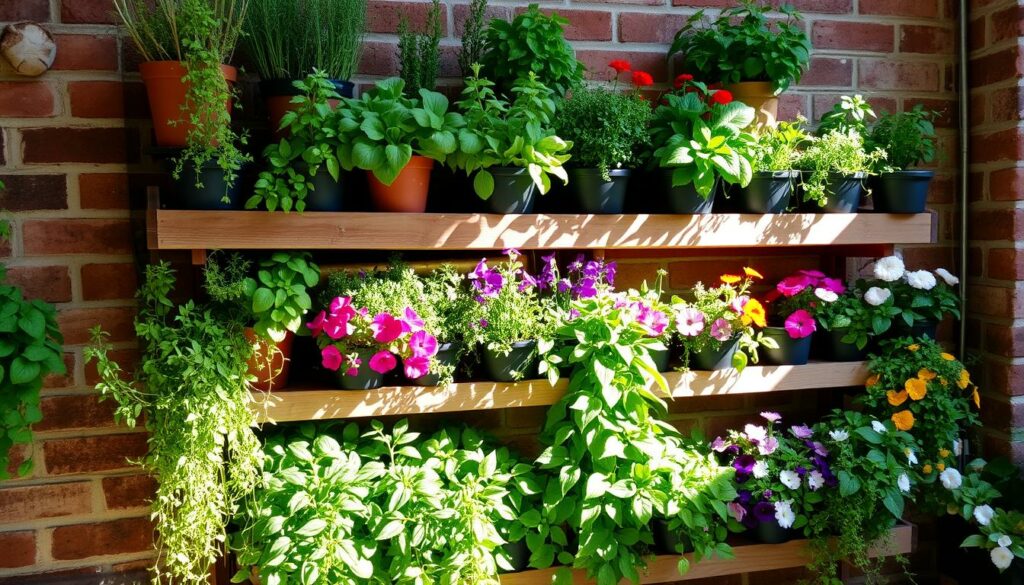If you have little yard space but love gardening, container gardening is for you. It turns small areas like balconies, patios, or windowsills into lush gardens. This guide helps both new and experienced gardeners grow a successful container garden. Enjoy fresh produce and colorful flowers right at your fingertips.
Key Takeaways
- Container gardening lets you grow many plants in small spaces like balconies, patios, and indoors.
- It brings fresh, homegrown food and stunning flowers to your space, no big yard needed.
- The right container, soil, and plants make even tiny spaces bloom.
- Container gardening is perfect for beginners or those with mobility issues.
- Keeping your garden healthy means regular watering, fertilizing, and pest control.
Introduction to Container Gardening
Gardening in small spaces is now more popular than ever. Container gardening is a great solution. It lets you grow vegetables, herbs, flowers, and fruits on your balcony, patio, or indoors. It’s perfect for those with little outdoor space, like Apartment Gardening or Miniature Gardens.
Benefits of Container Gardening
Container gardening is easy to manage. It needs less weeding, pest control, and upkeep than traditional gardens. You can also move plants to get the best sunlight or to look better. Plus, it’s great for Vertical Gardening and Raised Bed Gardening, making the most of your space.
Choosing the Right Containers
Choosing the right containers is key for a successful container garden. Think about size, material, and drainage. Big plants like tomatoes need deep, roomy containers. Smaller plants like herbs do well in smaller pots. Pick containers that are durable, like plastic, ceramic, or wood, and make sure they have holes for water to drain.
“Gardening is the art that uses flowers and plants as paint, and the soil and sky as canvas.”
– Elizabeth Murray
Selecting Plants for Container Gardens
For Vegetable Container Gardening, many plants do well in small spaces. Beans, carrots, lettuce, peppers, radishes, spinach, and tomatoes are great choices. Look for compact varieties like “Contender” beans and “Salad Bowl” lettuce for Edible Container Gardens.
Fruits for Container Gardens
Fruit Container Gardening can also be rewarding, offering a lot from little space. Blueberries, raspberries, strawberries, and dwarf trees like citrus or fig are good options. Choose varieties like “Sunshine Blue” blueberries for container gardening.
“Gardening in containers allows you to grow a wide variety of produce, even in the smallest of spaces. With the right plants and techniques, you can enjoy a thriving container garden full of fresh, homegrown goodness.”
Choosing the right plants for Vegetable Container Gardening, Edible Container Gardens, and Fruit Container Gardening makes a diverse garden possible. Even in small outdoor spaces, you can have a fruitful harvest. With some planning and the right plants, your garden will flourish.
Preparing Containers and Potting Mix
To grow a great container garden, you need to prepare your containers and potting mix well. Don’t use heavy garden soil because it can get too dense and block water. Instead, pick a high-quality, well-draining potting mix made for containers. These mixes have compost, peat moss, perlite, and vermiculite. They help your plants get the air and nutrients they need.
When picking a Container Gardening Soil or Potting Mix for Containers, look for one that drains well and is full of nutrients. Adding organic fertilizer or compost to your mix can make it even better. This way, your plants will get all the food they need to grow well.

- Choose a high-quality, well-draining potting mix designed for container gardening.
- Avoid using heavy garden soil, as it can become compacted and hinder drainage.
- Enhance the potting mix with organic fertilizer or compost to boost soil fertility.
- Ensure the container has adequate drainage holes to prevent waterlogging.
By carefully preparing your containers and potting mix, you’ll create a beautiful and productive container garden. It will flourish in even the smallest spaces.
Expert Tips for Successful Container Gardening
To keep your container garden healthy, focus on Container Garden Watering and Container Garden Fertilizing. Potted plants dry out quickly, so check the soil often. Water when it’s dry, especially in hot weather. Use a balanced fertilizer every two to four weeks to feed your plants well.
Container gardens face fewer Container Garden Pests and Container Garden Diseases than in-ground gardens. Still, watch your plants closely and prevent problems. Use natural pest control and keep plants from getting too crowded to avoid diseases.
Watering and Fertilizing
- Check soil moisture regularly and water as needed, especially in hot or dry weather
- Apply a balanced, water-soluble or slow-release organic fertilizer every 2-4 weeks
- Ensure plants receive the necessary nutrients for healthy growth and bountiful harvests
Pest and Disease Management
- Monitor plants for common issues like aphids, spider mites, powdery mildew, and fungal diseases
- Use organic pest control methods, such as introducing beneficial insects or applying insecticidal soaps
- Maintain good air circulation and avoid overcrowding to reduce the risk of disease development
| Watering Considerations | Fertilizing Recommendations | Common Pests | Common Diseases |
|---|---|---|---|
| Check soil moisture daily | Apply a balanced, water-soluble fertilizer every 2-4 weeks | Aphids, spider mites | Powdery mildew, fungal diseases |
| Water when the top inch of soil is dry | Use a slow-release organic fertilizer for a steady nutrient supply | Introduce beneficial insects for natural pest control | Maintain good air circulation to prevent disease development |

“The key to a thriving container garden is to stay vigilant with watering, fertilizing, and pest management. With the right care, your plants will thrive and reward you with abundant harvests.”
Container Gardening for Small Spaces
You can still have a beautiful garden, no matter how small your outdoor area is. Container gardening is a great way to use your space well and create a green oasis, even in tiny areas.
Maximizing Space with Vertical Gardening
For a small garden, think up. Use Vertical Container Gardening like hanging baskets or wall planters. This way, you can grow plants like strawberries, cucumbers, or small tomatoes without taking up too much space.
Creative Container Ideas for Small Spaces
Container gardening isn’t just about pots. Try Unique Container Gardening with things like old wheelbarrows or wooden crates. These Repurposed Containers not only hold your plants but also make your garden more interesting.
| Container Idea | Suitable Plants |
|---|---|
| Hanging Baskets | Trailing flowers, herbs, strawberries |
| Tiered Planters | Dwarf vegetables, herbs, succulents |
| Recycled Sinks | Leafy greens, small tomatoes, peppers |
“Thinking outside the pot is the key to creating a thriving container garden in a small space.”

By using Vertical Container Gardening and creative ideas, you can turn any small outdoor space into a beautiful, productive garden.
Container Garden Designs and Combinations
When designing your Edible Landscaping or Vegetable Container Garden Design, think about mixing both useful and pretty elements. By blending Edible Container Gardens with Decorative Container Gardens, you can make your small garden space better.
Edible Container Gardens
Make the most of your Edible Landscaping by creating gardens that have veggies, fruits, and herbs. Try a “salsa garden” with tomatoes, peppers, onions, and cilantro. Or, have a “cocktail garden” with a lemon tree and mint and strawberries around it. These gardens give you lots of food and look great, perfect for your outdoor areas.
Ornamental Container Gardens
Container gardens can also be full of Flowering Container Gardens with pretty flowers and leaves. Use colorful annuals like impatiens, marigolds, pansies, petunias, and zinnias for bright colors. Mix these with plants that trail or evergreen herbs for stunning, easy-to-care-for gardens. They’re great for looking at and smelling.
| Edible Container Gardens | Ornamental Container Gardens |
|---|---|
|
|
“Carefully curated container garden combinations not only provide a bountiful harvest but also offer visual appeal, perfect for strategically placed around your outdoor living spaces.”
Maintenance and Harvesting
Maintaining a thriving container garden needs regular care. This includes pruning and grooming. By doing so, you keep your plants healthy and productive.
Regularly remove dead or damaged leaves. Pinch off spent blooms. Trim overgrown herbs or vegetables. This helps them grow bushy and keeps your garden full of life.
Pruning and Grooming for Optimal Growth
Keeping your container garden in top shape is key. Always check for pests or diseases and deal with them quickly. Prune and groom your plants carefully, using clean tools to avoid harm.
Here are some tips to keep your garden looking great:
- Remove dead or damaged leaves to encourage new growth.
- Pinch off spent blooms to keep the plant flowering and save energy.
- Trim back overgrown herbs or vegetables for a neat look.
- Regularly check for pests or diseases and fix any problems fast.
When it’s time to harvest, do it carefully. Use clean tools to avoid harming the plant. Be aware of each plant’s growth habits to ensure a continuous harvest.
“Proper maintenance and regular harvesting are the keys to a thriving container garden. By staying on top of pruning, grooming, and harvesting, you’ll enjoy a bountiful and long-lasting harvest from your small-space oasis.”
Indoor Container Gardening
Discover the joy of Indoor Herb Garden and Houseplants in Containers at home. Container gardening works indoors too. You can grow a lush herb garden on your kitchen windowsill or leafy greens in bright living areas.
Indoor container gardening offers endless possibilities. Pick container-friendly houseplants like succulents, ZZ plants, or pothos. They add greenery, improve air quality, and bring peace.
“Indoor container gardens not only provide fresh ingredients and greenery but can also improve air quality and promote a sense of tranquility.”
You can even grow Indoor Herb Garden and Houseplants in Containers at home. With the right containers, soil, and sunlight, you’ll have fresh produce at your fingertips.
Thriving Indoors
To keep your indoor garden thriving, follow these tips:
- Choose containers with good drainage to avoid waterlogging.
- Use a potting mix made for container gardening that drains well and is rich in nutrients.
- Give your plants the right sunlight, either in a sunny spot or with grow lights.
- Water consistently, adjusting as needed to avoid too much or too little water.
- Regularly prune and groom your plants to keep them healthy and looking good.
| Indoor Plant | Sunlight Requirement | Watering Needs |
|---|---|---|
| Succulents | Bright, direct light | Allow soil to dry out between waterings |
| ZZ Plant | Moderate to low light | Water every 2-3 weeks |
| Pothos | Bright, indirect light | Water when the top inch of soil is dry |
By following these tips, you can turn your indoor spaces into lush gardens. This brings nature’s beauty and benefits into your home.
Conclusion
Container gardening is a great way to garden in small spaces. It lets you grow your own food and plants, even in tiny areas. By picking the right containers and soil, and choosing the right plants, you can turn any small space into a garden.
This guide has given you the knowledge to enjoy Container Gardening Tips. You now know how to water, fertilize, and deal with pests and diseases. Whether you’re new to gardening or have been doing it for years, container gardening is rewarding. It brings fresh food and beautiful flowers into your life.
Keep enjoying your container gardening journey. Try new designs and enjoy the fruits of your labor. Start with a green thumb and an open heart. Let gardening in small spaces bring joy and beauty into your life.
FAQ
What are the benefits of container gardening?
What are some good vegetable options for container gardening?
Can I grow fruits in containers?
What type of potting mix should I use for my container garden?
How do I maintain proper watering and fertilizing for my container garden?
How can I maximize space in my small container garden?
Can I grow both edible and ornamental plants in my container garden?
Can I grow a container garden indoors?
Source Links
- Use Container Gardening to Create a Small Vegetable Garden – Sharon Palmer, The Plant Powered Dietitian
- Container Garden Ideas for Growing TONS of Food in a Small Space – Garden Therapy
- Growing Bonsai: Tips for Miniature Tree Enthusiasts
- Buying Bonsai: Tips for Selecting Your Perfect Tree
- Bonsai Potting: Essential Tips for Tree Care Success
- Bonsai Maintenance: Essential Care for Tiny Trees
- Mastering the Art of Shaping Bonsai: A Beginner’s Guide


